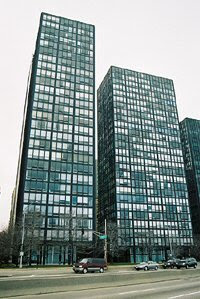The Seagram Building by Meis Van der Rohe exemplifies his simplistic view of architecture and the International Style. No extra “fluff” was added to the structure, it followed Mies’ opinion that “form follows function”. Michael Graves’ Portland Public Service Building goes in completely different direction than the Seagram’s building. The Portland building is much less sleeker than the Seagram building and it has unnecessary features, such as the maroon, black and purple decoration running up the middle whereas the Seagram building is basically a wall of glass. The Seagram building’s “wall of glass” structure made of steel, copper, and glass contrasts to the concrete structure with individual window holes of the Portland building. However, both buildings show a break in traditional architecture and exhibit original and new ways of thinking that would continue to influence future architects to come.




Both Mies and Graves made furniture. Mies’s Barcelona chair exhibits all of his stylistic beliefs. The chair is simple, but made from the best materials he could find so that the chair would last as long as possible. Graves’ chair is curved and uses more materials than needed.


2. Please choose five examples to show how Phillip Johnson's acrhitecture moved from Modernism to Post-modernism. You must cite the Glass House and the AT&T Building.
Johnson’s “Glass House” exemplifies the Modern style that he learned from his mentor, van der Rohe. The “Glass House” is literally made of all glass with steel posts, the only room not visible from the outside is the bathroom. It has a flat ceiling and the post and lintel form that was essential to the Modernism architecture.

His Chapel of St. Basil shows the beginning of his experimentation with the Modernist style. He doesn’t use the glass curtain effect for the walls, but the simplistic post and lintel theme is definitely present.

The Puerta de Europa in Madrid, Spain shows a big shift in Johnson’s style. The building does use the glass curtain effect, but the structure itself is inclined at a 15 degree angle. That inclination goes against the Modernist idea that “form follows function” because the building does not need to be inclined to fulfill its function.
_06.jpg)
The PPG Palace in Pittsburgh also utilizes the glass curtain for its exterior to advertise the product of the company that uses the building, the Pittsburgh Plate Glass Company. However, the structure features decorative glass spires on the roof. The word “decorative” would never be used in describing a building done in the Modernist style.

The AT&T building is considered post-modern because of its use of decorative elements, such as the 7 story arching entryway and the decorative open pediment top.

3. Please describe the architecture of the Pompidou Centre.
The Pompidou centre is classified as post-modern or high-tech architecture. It is a steel structure reinforced with concrete floors.4. Please identify works by and give a brief synopsis for each: Renzo Piano, Mario Botta (must be SFMoMA), Peter Eisenman, Zaha Hadid (must be The Firehouse), Daniel Liebskind (must be the Jewish Museum in Berlin).
Renzo is best known for his work in the Pompidou Centre. The Centre is one of the most original and unorthodox approaches to architecture that the world has ever seen. It is considered to be built in the high-tech style. (see question number 3)

Mario Botta designed the San Francisco Museum of Modern Art. It is built in the post-modern style. It is a red brick building that features a black and white cylinder that protrudes from the middle, forming an atrium.

Peter Eisenman designed the Memorial to the Murdered Jews of Europe in Berlin. It consists of 2,711 concrete slabs covering a 4.7 acre plot with an information room located underground. The slabs are meant to create a feeling of unrest and confusion, while the entire project follows a pattern and is ordered, but gives off an inhuman air.

Zaha Hadid is considered a deconstructionist architect. She designed the Vitra Firehouse. The structure is basically made of steel enforced concrete slabs resembling monoliths.

Daniel Liebskind designed the Jewish Museum in Berlin. It is a zig-zagging structure that looks like a warped Star of David. On the interior it has a “void” or empty black space is present above throughout the entire structure. An irregular pattern of windows can be seen best from the exterior.


No comments:
Post a Comment